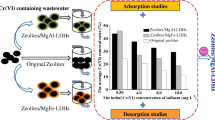Abstract
In this study, for the first time, sodium hexametaphosphate (SHMP) was used as a dispersant in the production of nanozeolites. In addition, the effect of SHMP on the adsorption of ion metals by nanozeolite was investigated. In order to characterize the prepared nanozeolite by a planetary mill, the scanning electron microscope (SEM) was used. The SEM photographs showed that the planetary mill could produce the nanoparticles of zeolites. Furthermore, according to the SEM and X-ray diffraction (XRD) results, the zeolite samples milled with SHMP have regular and fine particles in comparison with nanozeolites produced without SHMP. On the other hand, the nanozeolites produced with SHMP have high qualification. According to the size fraction results, in the presence of SHMP, less than 15 % (3 g) of the milled sample remained on the 20-micron sieve, while 70 % (14 g) of the milled sample without SHMP remained on the 20-micron sieve. Finally, a series of experiments was performed to study the effect of SHMP on the adsorption of nickel, cadmium and copper ions using nanoparticles of zeolite. As a result, the adsorption percentage of nickel and cadmium on nanozeolites pretreated by SHMP is higher for times less than 2 h and more than 6 h in comparison with nanozeolites not pretreated by SHMP. On the other hand, the effect of SHMP on the adsorption of copper by nanozeolite is not significant. This insignificant effect probably occurs due to the stronger interaction of Cu2+ and AlO4− than that of Cu2+ and SHMP.








Similar content being viewed by others
References
Akçay K, Sirkecioğlu A, Tatlıer M, Savaşçı ÖT, Erdem-Şenatalar A (2004) Wet ball milling of zeolite HY. Powder Technol 142:121–128. doi:10.1016/j.powtec.2004.03.012
Bilici Baskan M, Pala A (2011) Removal of arsenic from drinking water using modified natural zeolite. Desalination 281:396–403. doi:10.1016/j.desal.2011.08.015
Charkhi A, Kazemian H, Kazemeini M (2010) Optimized experimental design for natural clinoptilolite zeolite ball milling to produce nano powders. Powder Technol 203:389–396. doi:10.1016/j.powtec.2010.05.034
Chen Q, Jin YL, Lu QM, Ding SJ, Jiang JL, Chen J (2014) Nano-dispersion behavior and crystal-bundles dissociation of palygorskite under water. J China Univ Min Technol (Chin) 43:521–525
Dimirkou A (2007) Uptake of Zn2+ ions by a fully iron-exchanged clinoptilolite. Case study of heavily contaminated drinking water samples. Water Res 41:2763–2773
Dimirkou A, Doula MK (2008) Use of clinoptilolite and an Fe-overexchanged clinoptilolite in Zn2+ and Mn2+ removal from drinking water. Desalination 224:280–292. doi:10.1016/j.desal.2007.06.010
Doula MK (2007) Synthesis of a clinoptilolite–Fe system with high Cu sorption capacity. Chemosphere 67:731–740. doi:10.1016/j.chemosphere.2006.10.072
Doula MK, Dimirkou A (2008) Use of an iron-overexchanged clinoptilolite for the removal of Cu2 + ions from heavily contaminated drinking water samples. J Hazard Mater 151:738–745. doi:10.1016/j.jhazmat.2007.06.047
Erdal E (2009) Removal of lead ions by Unye (Turkey) bentonite in iron and magnesium oxide-coated forms. J Hazard Mater 165:63–70
Esmaeili N, Kazemian H, Bastani D (2011) Synthesis of nano particles of LTA zeolite by means of microemulsion technique. Iran J Chem Chem Eng (IJCCE) 30:1–8
Gedik K, Imamoglu I (2008) Removal of cadmium from aqueous solutions using clinoptilolite: influence of pretreatment and regeneration. J Hazard Mater 155:385–392
Gutiérrez-Segura E, Solache-Ríos M, Colín-Cruz A, Fall C (2012) Adsorption of cadmium by Na and Fe modified zeolitic tuffs and carbonaceous material from pyrolyzed sewage sludge. J Environ Manag 97:6–13. doi:10.1016/j.jenvman.2011.11.010
Madsen C, Jacobsen CJH (1999) Nanosized zeolite crystals-convenient control of crystal size distribution by confined space synthesis. Chem Commun 673–674. doi:10.1039/A901228A
Merrikhpour H, Jalali M (2013) Comparative and competitive adsorption of cadmium, copper, nickel, and lead ions by Iranian natural zeolite. Clean Technol Environ Policy 15:303–316. doi:10.1007/s10098-012-0522-1
Rodríguez-Iznaga I, Rodríguez-Fuentes G, Benítez-Aguilar A (2000) The role of carbonate ions in the ion-exchange Ni2+=2NH4 + in natural clinoptilolite. Microporous Mesoporous Mater 41:129–136. doi:10.1016/S1387-1811(00)00280-8
Rodríguez-Iznaga I, Gómez A, Rodrı́guez-Fuentes G, Benítez-Aguilar A, Serrano-Ballan J (2002) Natural clinoptilolite as an exchanger of Ni2+ and NH4 + ions under hydrothermal conditions and high ammonia concentration. Microporous Mesoporous Mater 53:71–80. doi:10.1016/S1387-1811(02)00325-6
Sauer J, Nachtigallova D, Nachtigall P (2001) AB initio simulation of Cu-species in zeolites: siting, coordination, UV-Vis spectra and reactivity. In: Centi G, Wichterlová B, Bell AT (eds) Catalysis by unique metal ion structures in solid matrices: from science to application. Springer, Dordrecht, Netherlands, pp 221–234
Tehrani Matin K, Bastani D, Kazemian H (2009) Applying the Taguchi method to develop an optimized synthesis procedure for nanocrystals of T-Type zeolite. Chem Eng Technol 32:1042–1048. doi:10.1002/ceat.200900061
Trgo M, Perić J, Medvidović NV (2006) Investigations of different kinetic models for zinc ions uptake by a natural zeolitic tuff. J Environ Manage 79:298–304. doi:10.1016/j.jenvman.2005.07.009
Wang W, Wang A (2016) Recent progress in dispersion of palygorskite crystal bundles for nanocomposites 119. Appl Clay Sci 1:18–30. doi:10.1016/j.clay.2015.06.030
Wang B, Zhu MH, Shi QZ (2002) Synthesis of nanosized NaY zeolite by confined space method. Chin Chem Lett 13:385–388
Xie J, Kaliaguine S (1997) Zeolite ball milling as a means of enhancing the selectivity for base catalyzed reactions. Appl Catal A 148:415–423. doi:10.1016/S0926-860X(96)00234-7
Yavuz O, Altunkaynak Y, Guzel F (2003) Removal of copper, nickel, cobalt and manganese from aqueous solution by kaolinite. Water Res 37:948–952. doi:10.1016/S0043-1354(02)00409-8
Author information
Authors and Affiliations
Corresponding author
Rights and permissions
About this article
Cite this article
Irannajad, M., Kamran Haghighi, H. & Mohammadjafari, A. Heavy metals adsorption by nanozeolites: effect of sodium hexametaphosphate. Environ Earth Sci 75, 1058 (2016). https://doi.org/10.1007/s12665-016-5851-7
Received:
Accepted:
Published:
DOI: https://doi.org/10.1007/s12665-016-5851-7




